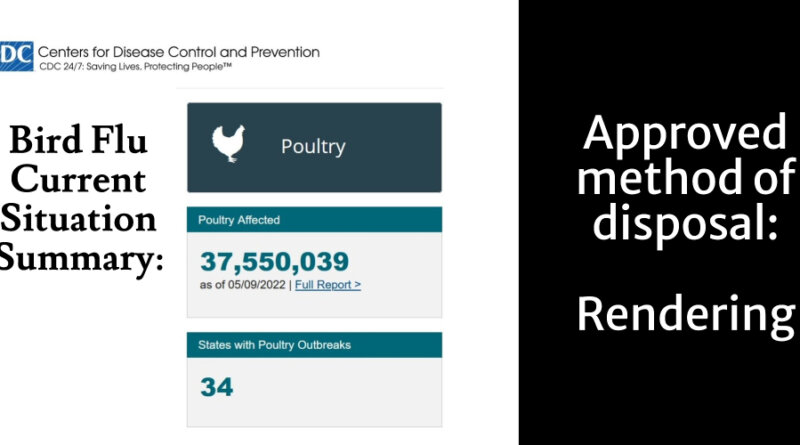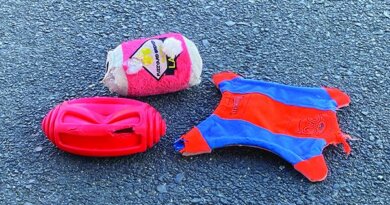Does Your Pet Food Contain Avian Flu Infected Poultry? – Truth about Pet Food
The Centers for Disease Control (CDC) is reporting that 34 US states have seen outbreaks of avian flu in poultry flocks. Since this outbreak began in January 2022 (as of May 9, 2022) more than 37 million birds in the US have been killed (termed as depopulated) due to the virus. The big questions for pet owners: how are those millions of poultry carcasses disposed of? Will they end up in pet food?
The USDA has a document specific to the depopulation of avian flu poultry and the disposal of those birds. The USDA allows avian flu poultry to be disposed of by “composting, burial, incineration, rendering, and landfilling“, and states that “depending on the situation” all of the available disposal options will be used. This means—with certainty—some of the depopulated avian influenza poultry will end up as rendered ingredients in pet food.
The USDA document explains the rendering depopulation method as: “This involves processing carcasses until they are reduced to water, fat or tallow, and meat or bone meal.” This tells us that the avian flu depopulated poultry will become the commonly used pet food ingredients chicken meal, turkey meal, chicken by-product meal, turkey by-product meal, and chicken fat.
The FDA does NOT require pet food manufacturers to disclose if any ingredient was sourced from avian flu depopulated poultry.
Could rendered ingredients be contaminated with avian flu? Absolutely yes. The goal of any heat step such as rendering is to destroy all pathogens. As many pathogenic bacteria pet food recalls evidence, pathogens often survive the rendering of ingredients and/or the pet food cooking process. Specific to avian flu and rendered ingredients, the USDA states rendering sick birds “is very effective but requires added safety precautions to make sure the virus does not become aerosolized and dispersed throughout the rendering plant.” One mistake, one lax safety precaution could result in the virus being spread to millions/billions of pounds of rendered ingredients.
Dogs and cats are susceptible to avian influenza, however cats appear to be more susceptible. The New York Health Department stated: “In 2016, over 100 cats and one person in NYC tested positive for a low pathogenic avian influenza known as H7N2.” The current outbreak of avian influenza is considered “highly pathogenic“.
The other issue of concern is how avian flu infected flocks of poultry are depopulated, and would depopulation methods be a risk in rendered ingredients? The USDA document (linked above) states that the common methods “to depopulate HPAI-affected flocks: water-based foam for floor-raised birds and carbon dioxide gas for caged birds.” No authority (FDA or USDA) provides assurances to pet owners that foam killed or carbon dioxide killed flu infected birds are safe for pets to consume.
Pet owners are caught in the middle of government agency jurisdiction. The USDA has jurisdiction over the depopulation methods, the sick birds and the rendering facilities that would process the sick poultry. But the USDA has no jurisdiction over the pet food ingredients that are produced by the rendering process. All pet food ingredients fall into FDA jurisdiction.
In other words, the risk to pets consuming depopulated avian flu infected poultry is not considered by USDA. USDA can decide how best to depopulate 37+ million of poultry giving (hopefully) some respect to end of life for the poultry—but they make those decisions without one concern to the pet edible product (allowed by FDA) produced through depopulation. On the other side of things, the FDA allows these ingredients to be used in pet food with no regulatory ‘say’ in safe for pets to consume methods for depopulation. Are these ingredients safe? We don’t know. But we do know that no authority is providing pet owners with assurances that the sick birds or the depopulation methods result in safe for pets to consume ingredients.
We have sent questions to FDA Center for Veterinary Medicine asking if FDA has directly allowed rendered depopulated avian flu birds into pet food and we asked if FDA believes pet owners should be informed what they are purchasing (with a disclosure on the label). We don’t expect to hear back from FDA CVM anytime soon, it often takes months for them to respond to our questions.
Waste—such as the rendered carcasses of foam or carbon dioxide depopulated avian flu infected poultry, 37 million carcasses—is an ugly truth of pet food. An ugly truth that no one of authority wants to talk about.
But…it HAS TO BE publicly discussed and disclosed on pet food labels (if they are going to continue to allow waste to be disposed of into pet food). To keep this ugly truth silent, is deceiving millions of pet owners and potentially putting millions of pets at risk.
Please send a message to FDA Center for Veterinary Medicine, asking them if they are allowing rendered avian flu infected depopulated poultry to be processed into pet food. Ask them for FDA assurance that the sick birds and the depopulation methods used are safe for pets to consume. Ask them to issue a public statement alerting pet owners that depopulated avian flu infected poultry are being processed into pet food, and to publicly provide scientific evidence these rendered ingredients are safe for pets to consume. Email FDA CVM at: AskCVM@fda.hhs.gov.
If your pet’s food or treat contains the ingredients chicken meal, turkey meal, chicken by-product meal, turkey by-product meal, poultry fat or chicken fat – ask the manufacturer for a written guarantee the ingredient is not sourced from avian flu depopulated poultry.
Wishing you and your pet the best –
Susan Thixton
Pet Food Safety Advocate
TruthaboutPetFood.com
Association for Truth in Pet Food

Become a member of our pet food consumer Association. Association for Truth in Pet Food is a a stakeholder organization representing the voice of pet food consumers at AAFCO and with FDA. Your membership helps representatives attend meetings and voice consumer concerns with regulatory authorities. Click Here to learn more.
What’s in Your Pet’s Food?
Is your dog or cat eating risk ingredients? Chinese imports? Petsumer Report tells the ‘rest of the story’ on over 5,000 cat foods, dog foods, and pet treats. 30 Day Satisfaction Guarantee. Click Here to preview Petsumer Report. www.PetsumerReport.com
Find Healthy Pet Foods in Your Area Click Here

The 2022 List
Susan’s List of trusted pet foods. Click Here to learn more.





buy cialis without prescription: viagra cialis levitra trial pack cheap cialis generic online
deep web markets tor markets 2023
tor darknet darknet market
black internet darknet market